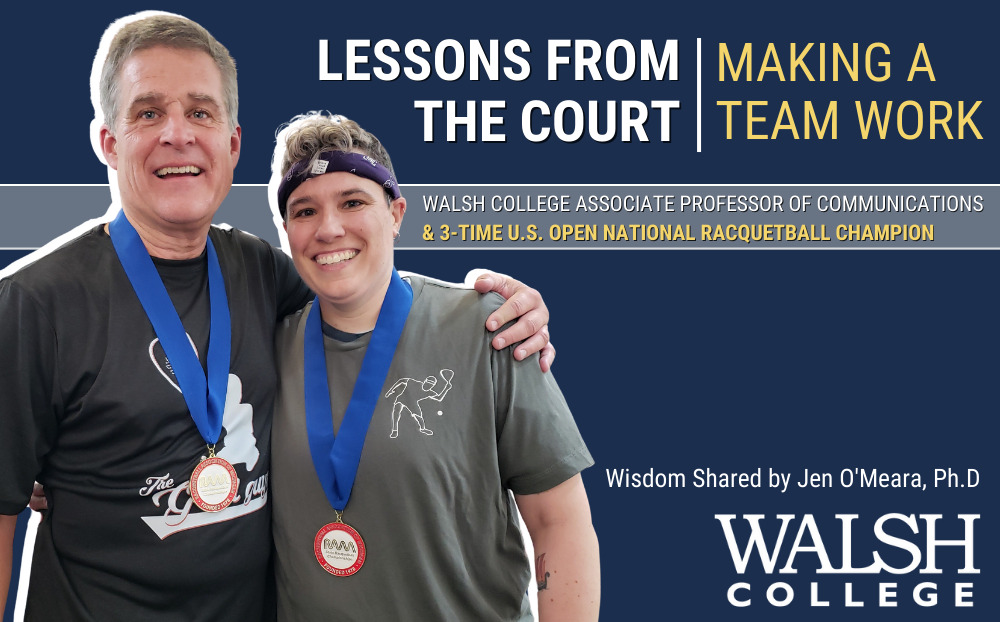Lessons From the Court: Making a Team Work
By: Jen O’Meara, Ph.D.
Let’s talk today about teams: how to think about them, how to create them, and how to make them work.
Many racquetball players prefer to play singles (ie. one on one against an opponent) rather than doubles (ie. with a partner against a pair of opponents). I get it. A racquetball court is a relatively small space for two people swinging racquets at a speeding ball — let alone four. Safety concerns, however, are rarely the reason that players shy away from doubles. Most players who don’t play doubles say they would rather lose a match based on their own performance rather than on someone else’s. In short, they don’t want a teammate to drag them down.
The same complaint about teamwork exists in the workplace as well. Many employees would prefer to work as individuals rather than as part of a group. Again, I get it. Working alone allows an individual to make their own decisions, work at their own pace, and ensure that their project is of the highest quality possible. In other words, people in the workplace don’t want teammates to drag them down.
I’d like to suggest that assuming a teammate will be a liability is not exactly the best way to think about teamwork. Indeed, if your organization is structured around teams, adopting that assumption will almost guarantee that your work will be more stressful than it needs to be. The most effective teams are synergistic, which means that they are more productive and achieve better results than team members could as individuals. That is a key point to remember.
This point in turn begs the question as to how to create an “effective team.” Effective teams in the workplace and on the racquetball court are composed of individuals with complementary skills. In order to identify who would make a good teammate for you, you need to know and understand your own strengths and weaknesses. Be honest with yourself when making those assessments. If you’re not, you may be assigned a task that’s not in your wheelhouse — and when that happens, YOU become the weak teammate.
I use exactly this strategy when choosing my doubles partners. My reflexes are well suited for front court play, so I know I need a partner who is strong from the back. As a woman who plays primarily in the men’s divisions, I typically have neither the reach nor the power of my opponents, so I know I also need a partner who has enough speed to cover shots I can’t reach and enough power for both of us. Enter Steve. He and I won the Mixed A Doubles division at the 2021 US Open and, more recently, the Men’s Centurion Open division at the Michigan State Doubles tournament in December of 2022.
This same principle should be used for creating teams in the workplace. If one teammate is particularly good with details, add a complementary teammate who sees the big picture. Someone with an analytical mind can be complemented with a teammate who has an eye for presentation design. Information Technology professionals are good counterparts to a variety of business experts. We know that the most effective teams are those composed of people with diverse talents and worldviews.
In addition to getting the right people on the team and assigning tasks that allow team members to work to their strengths, it is also important to make sure that everyone on the team knows exactly what they are responsible for. The hazard otherwise is that a task could slip through the cracks or that two teammates might unknowingly work on the same task, neither of which is desirable. Also, if you are still concerned about a teammate letting you down, a clear division of responsibilities should help, as that will help show which teammate didn’t pull their weight.
The next time someone suggests teamwork, I encourage you to give it a try, keeping in mind that an effective team has the potential to take you higher and further than you might otherwise get on your own.
Jen O’Meara is an Associate Professor of Business Communications and a 3-time US Open national racquetball champion.







